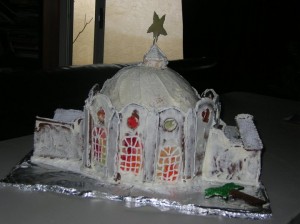Gingerbread Temple Revisited
Dec 10th, 2011 by admin
The Life Spirit and the vital body started their evolution in the Sun Period and are consequently the particular charges of the Son.
The Vital Body, p11, Max Heindel.
Last year’s Gingerbread Temple by Roger and Cindy Cosio delighted our RF friends, especially those who have been privileged to attend Temple and Healing Services at Mount Ecclesia. [See story in December 2010 Archive] As the Life
Spirit of Christ fills that very special place on earth and also fills our hearts to abundance in this most sacred of all seasons, we felt it timely to revisit, if not by pilgrimage, at least by our joyous reverence.
The Wisconsin State Journal printed a recipe for gingerbread recently which included the construction how-to for building the confectionary structures. That brought it to mind, so we thought, why not bring those charming pictures back for all who did not see them last year and as a sweet remembrance for those who did. After all, nostalgia feeds on repetition, and repetition builds the vital body.
Now, at Christmas 2011, you will also have the recipe and instruction of how to build either a Gingerbread House, a Gingerbread Temple, or possibly a church with a steeple; whatever suits the architectural skill and design preference of your “Master Builder.”
Once you form the vision in your mind and draw the plan of your intended structure, thus creating the archetype; then, it is time to begin the other labor, that of mixing the ingredients for the dough.
Gingerbread
2 3/4 cups flour
1/2 teaspoon salt
1 teaspoon ginger
1/8 teaspoon cloves
1 teaspoon cinnamon
1 tablespoon baking powder
2/3 cup molasses
1 egg, slightly beaten
1/2 cup brown sugar, packed
1/2 cup vegetable oil
Sift together the dry ingredients. Add the remaining ingredients and mix together thoroughly for dough. Chill overnight or longer.
Roll the dough out in an 11 x 15-inch rectangle on an oiled piece of foil and place it on a cookie sheet. Bake at 300° for 30 minutes.
After baking, place the paper or cardboard pattern on the hot gingerbread (the pattern on the right can be scaled to your project). Cut it with a sharp knife. Lift the pieces carefully and place them on a cake rack to cool. The gingerbread should be very hard when cool. If necessary, the pieces can be put back on the cookie sheet and placed in the oven for five or ten minutes to make them stiffer, as pieces will break during assembly if not thoroughly baked.
Royal Icing
3 egg whites, at room temperature
1 pound confectioner’s sugar
½ teaspoon cream of tartar
Beat thoroughly in a bowl. The icing is ready to use when it forms firm peaks that stick to the beaters when lifted. It should have a dull sheen but not be shiny.
Use immediately, keeping the icing in a bowl covered with a damp cloth, because it will quickly dry out and harden. Food coloring may be added to color it green or other colors for decorating.
For a stiffer royal icing, add more egg whites or reduce the amount of sugar. If you plan to eat the house, use meringue powder (available at specialty stores) instead of egg whites. See assembly instructions at http://host.madison.com/photos-gingerbread-house-making/collection_50b12598-21d2-11e1-b628-001871e3ce6c.html?mode=image&photo=1
Some masons prefer using white chocolate for the mortar to hold the sections together and use the royal icing only for decorating.
For the temple, Roger writes: “As I recall we winged it quite a bit. In fact, Cindy made the 12 sides too tall and they had to be trimmed. The circle windows should be cut out of the gingerbread dough BEFORE being baked (so much easier before). The white cake frosting helped in so many ways; it was glue for broken parts; it was glue for non-broken parts coming together; it made the brown temple white; it coated the rice krispy dome.
“From memory, for the stained glass, cindy and I crushed some lifesaver candies, shaped the crumbs into windows on wax paper, then melted them in the oven. I think we had to trim them into shape after they came out of the oven.
“The star on top of the dome was done with melted, yellow lifesavers only …with a toothpick melted into the star and poked into the dome at the top.
“For the dome, we also used wax paper on the outside, bottom of one of our big bowls ; thenformed a fresh batch of rice crispy treat around it, enough to be sticking up out of the top of the raised “dodecahedron” (12) sides of the temple.
“Later we cheated and used pieces of cloth or a small towel (not edible) under the dome to bring it up to the correct height and also to support it.”
The Masonic legend relates that the Queen of Sheba journeyed from afar to see the wise Solomon of whom she had heard so much. She was also shown the beautiful temple and wanted to see the cunning craftsman, the master builder and his workmen who had wrought such a marvel. The Rosicrucian Philosophy in Questions and Answers, p445, Max Heindel.



